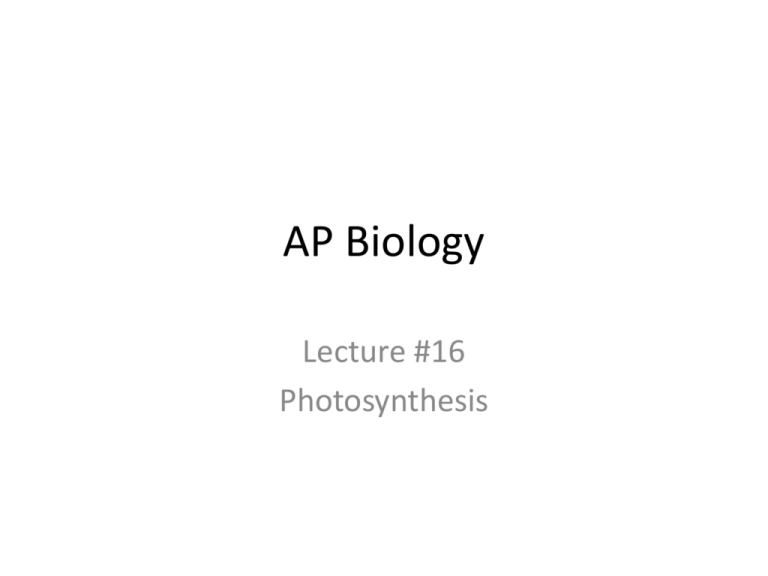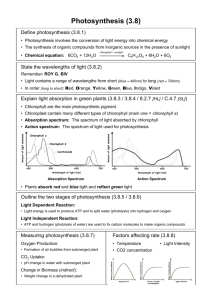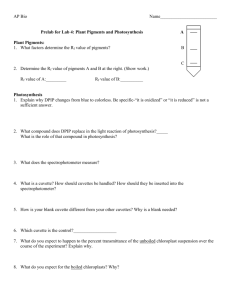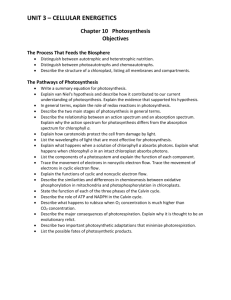AP Biology - NGHS
advertisement

AP Biology Lecture #16 Photosynthesis CO 7 Photosynthesis & Cellular Respiration Photosynthesis • Method of converting sun energy into chemical energy usable by cells • Autotrophs: self feeders, organisms capable of making their own food – Photoautotrophs: use sun energy e.g. plants photosynthesis-makes organic compounds (glucose) from light – Chemoautotrophs: use chemical energy e.g. bacteria that use sulfide or methane chemosynthesis-makes organic compounds from chemical energy contained in sulfide or methane energy input from sun Photoautotrophs (plants, other producers) nutrient cycling Heterotrophs (consumers, decomposers) energy output (mainly heat) Photosynthesis • Photosynthesis takes place in specialized structures inside plant cells called chloroplasts – Light absorbing pigment molecules e.g. chlorophyll http://www.youtube.com/watch?v=hj_WKgnL6MI& feature=player_embedded Figure 7.1a 7.1 Photosynthetic Organisms A. Photosynthesis transforms solar energy B. Organic molecules built by photosynthesis provide both the building blocks and energy for cells. Figure 7.1b C. Plants use the raw materials: carbon dioxide and water D. Chloroplasts carry out photosynthesis Figure 7.1c E. Chlorophylls and other pigments involved in absorption of solar energy reside within thylakoid membranes of chloroplasts Figure 7.2 7.2 Plants as Solar Energy Converters A. Solar Radiation - Only 42% of solar radiation that hits the earth’s atmosphere reaches surface; most is visible light. B. Photosynthetic Pigments - Pigments found in chlorophyll absorb various portions of visible light; absorption spectrum. 1. Two major photosynthetic pigments are chlorophyll a and chlorophyll b. 2. Both chlorophylls absorb violet, blue, and red wavelengths best. 3. Very little green light is absorbed; most is reflected back; this is why leaves appear green. 4. Carotenoids are yellow-orange pigments which absorb light in violet, blue, and green regions. 5. When chlorophyll breaks down in fall, the yellow-orange pigments in leaves show through. C. Absorption and action spectrum - A spectrophotometer measures the amount of light that passes through a sample of pigments. 1) As different wavelengths are passed through, some are absorbed. 2) Graph of percent of light absorbed at each wavelength is absorption spectrum . 3) Photosynthesis produces oxygen; production of oxygen is used to measure the rate of photosynthesis. 4) Oxygen production and, therefore, photosynthetic activity is measured for plants under each specific wavelength; plotted on a graph, this produces an action spectrum. 5) Since the action spectrum resembles absorption spectrum, this indicates that chlorophylls contribute to photosynthesis. T.E. Englemann’s Experiment • Observation: Photosynthesis produces oxygen. • Question: What parts of sunlight do plants favor? • Hypothesis: If bacteria require oxygen, then we can expect them to gather in places where the most photosynthesis is occurring. • Englemann showed that bacteria gathered around red and violet light (see next slide), indicating that these were the colors of light T.E. Englemann’s Experiment Bacteria gathered mostly where violet and red light fell on the green alga because Photosynthesis was greatest in those locations Pigments • Color you see is the wavelengths not absorbed (red shirt reflects red light and absorbs all other colors) • Light-catching part of molecule often has alternating single and double bonds • These bonds contain electrons that are capable of being moved to higher energy levels by absorbing light Variety of Pigments • Chlorophylls a (green, chloroplasts) • Chlorophyll b (bluish-green; plants, green algae, bacteria) • Carotenoids: absorb blue-violet wavelengths but reflect yellow, orange, and red (carrots,beta-carotene) • Anthocyanins: pigments in flowers • Phycobilins: red and blue pigments of red algae and cyanobacteria Chlorophylls Wavelength absorption (%) Main pigments in most photoautotrophs chlorophyll a chlorophyll b Wavelength (nanometers) Accessory Pigments percent of wavelengths absorbed Carotenoids, Phycobilins beta-carotene (carotenoid pigment) phycoerythrin (a phycobilin pigment) wavelengths (nanometers) D. Photosynthetic Reaction 1. In 1930 C. B. van Niel showed that O2 given off by photosynthesis comes from water and not from CO2. 2. The net equation reads: Overall Reaction • 6CO2 + 12 H2O + light energy → C6H12O6 + 6O2+ 6H2O • Carbohydrate made is glucose • Water appears on both sides because 12 H2O molecules are required and 6 new H2O molecules are made • Water is split as a source of electrons from hydrogen atoms releasing O2 as a byproduct • Electrons increase potential energy when moved from water to sugar therefore energy is required Overall Reaction LIGHT ENERGY 12H2O + 6CO2 Water Carbon Dioxide 6O2 + C6H12O 6 + 6H2O Oxygen Glucose Water E. Two Sets of Reactions in Photosynthesis 1. Light reactions cannot take place unless light is present. They are the energy-capturing reactions. b. Chlorophyl within thylakoid membranes absorbs solar energy and energizes electrons. c. Energized electrons move down the electron transport system; energy is captures and used for ATP production. d. Energized electrons are also taken up by NADP+, becoming NADPH. 2. Calvin Cycle Reactions a. These reactions take place in the stroma; can occur in either the light or the dark. b. These are synthesis reactions that use NADPH and ATP to reduce CO2. What you should know by now.. 1. The equation for photosynthesis 2. The structure of a chloroplast 3. Which spectrum(s) of light is used by plants and the pigments associated with light spectrum. 4. The two stages of photosynthesis and their products **Things are about to get much more difficult**




